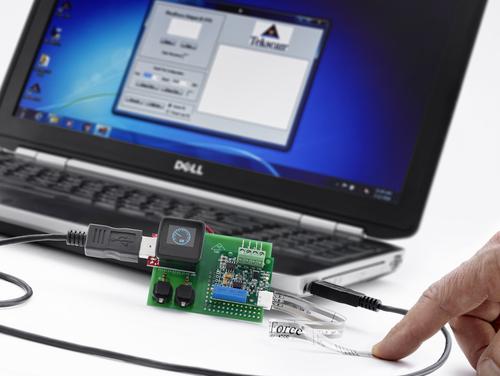Dev Kit Simplifies Force Sensor Applications
A new development kit expedites proof-of-concept for applications requiring an ultra-thin force or pressure sensor.
May 2, 2016
Introduced at the recent Embedded Systems Conference in Boston, the FlexiForce OEM Development Kit enables design engineers to quickly determine if a thin, piezo-resistive sensor will work for them. “It allows designers to put the sensor in the device they’re designing, load it up, and collect the data, with very little set up,” said Mark Lowe, vice president of sensor business at Tekscan, maker of the dev kit and the sensor.

The FlexiForce OEM Development Kit enables design engineers to quickly determine if a thin, piezo-resistive sensor will work for them.
(Source: Tekscan Inc.)
The new dev kit is targeted at medical systems, robotics, sports and fitness devices, and virtually any other application that uses force sensors. Lowe told Design News that the company’s customers have employed its sensors in knee replacement hardware, drug delivery systems, and in the soles of shoes, where they can be used to analyze a person’s gait.
The sensor itself is tiny -- measuring just about 0.008 inches (0.2 mm) thick. It uses a piezo-resistive (as opposed to piezo-electric) measurement technology atop a thin, flexible polyester substrate. “When you load it, the resistance changes, and the signal doesn’t decay,” Lowe told us. “So you can use it for static measurements.”
READ MORE ABOUT TEST AND MEASUREMENT:
The dev kit allows engineers to know if the technology works for their applications in as soon as 15-20 minutes. It contains a MicroView display module, USB programmer interface, analog front end FlexiForce Quickstart board, and software.
Lowe said the kit provides significant time savings for design engineers. “They don’t have to spend three or four or five hours cobbling something together and they don’t need a scope to collect the data,” he told us. “In minutes, they can know if this technology works for them.”
Keep up to date with advances in embedded systems by joining our ESC community.
Senior technical editor Chuck Murray has been writing about technology for 32 years. He joined Design News in 1987, and has covered electronics, automation, fluid power, and autos.
About the Author(s)
You May Also Like



